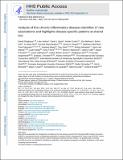Analysis of five chronic inflammatory diseases identifies 27 new associations and highlights disease-specific patterns at shared loci

View/
Author
Ellinghaus, David
Jostins, Luke
Spain, Sarah L
Cortes, Adrian
Bethune, Jörn
Han, Buhm
Park, Yu Rang
Pouget, Jennie G
Hübenthal, Matthias
Folseraas, Trine
Wang, Yunpeng
Esko, Tonu
Metspalu, Andres
Franke, Lude
Weersma, Rinse K
Collij, Valerie
D'Amato, Mauro
Halfvarson, Jonas
Jensen, Anders Boeck
Lieb, Wolfgang
Degenhardt, Franziska
Forstner, Andreas J
Hofmann, Andrea
Schreiber, Stefan
Mrowietz, Ulrich
Juran, Brian D
Lazaridis, Konstantinos N
Brunak, Søren
Dale, Anders M
Trembath, Richard C
Weidinger, Stephan
Weichenthal, Michael
Ellinghaus, Eva
Elder, James T
Barker, Jonathan NWN
Andreassen, Ole A
McGovern, Dermot P
Karlsen, Tom H
Barrett, Jeffrey C
Parkes, Miles
Brown, Matthew A
Franke, Andre
Note: Order does not necessarily reflect citation order of authors.
Published Version
https://doi.org/10.1038/ng.3528Metadata
Show full item recordCitation
Ellinghaus, D., L. Jostins, S. L. Spain, A. Cortes, J. Bethune, B. Han, Y. R. Park, et al. 2016. “Analysis of five chronic inflammatory diseases identifies 27 new associations and highlights disease-specific patterns at shared loci.” Nature genetics 48 (5): 510-518. doi:10.1038/ng.3528. http://dx.doi.org/10.1038/ng.3528.Abstract
We simultaneously investigated the genetic landscape of ankylosing spondylitis, Crohn's disease, psoriasis, primary sclerosing cholangitis and ulcerative colitis to investigate pleiotropy and the relationship between these clinically related diseases. Using high-density genotype data from more than 86,000 individuals of European-ancestry we identified 244 independent multi-disease signals including 27 novel genome-wide significant susceptibility loci and 3 unreported shared risk loci. Complex pleiotropy was supported when contrasting multi-disease signals with expression data sets from human, rat and mouse, and epigenetic and expressed enhancer profiles. The comorbidities among the five immune diseases were best explained by biological pleiotropy rather than heterogeneity (a subgroup of cases that is genetically identical to another disease, possibly due to diagnostic misclassification, molecular subtypes, or excessive comorbidity). In particular, the strong comorbidity between primary sclerosing cholangitis and inflammatory bowel disease is likely the result of a unique disease, which is genetically distinct from classical inflammatory bowel disease phenotypes.Other Sources
http://www.ncbi.nlm.nih.gov/pmc/articles/PMC4848113/pdf/Terms of Use
This article is made available under the terms and conditions applicable to Other Posted Material, as set forth at http://nrs.harvard.edu/urn-3:HUL.InstRepos:dash.current.terms-of-use#LAACitable link to this page
http://nrs.harvard.edu/urn-3:HUL.InstRepos:29407774
Collections
- HMS Scholarly Articles [17922]
Contact administrator regarding this item (to report mistakes or request changes)


